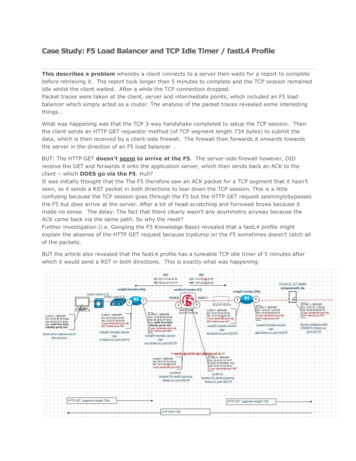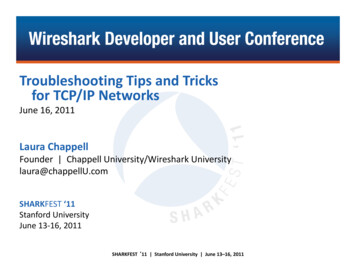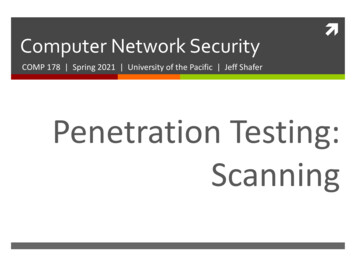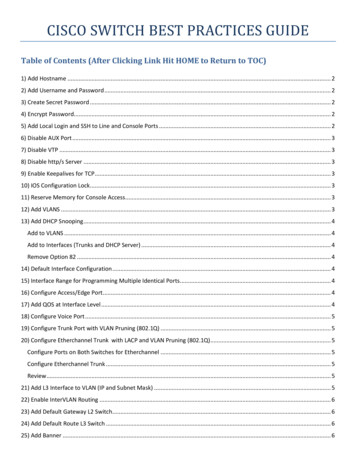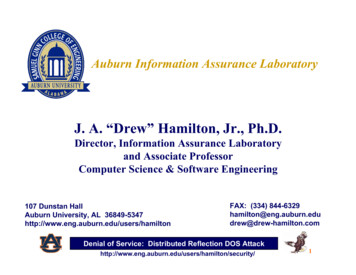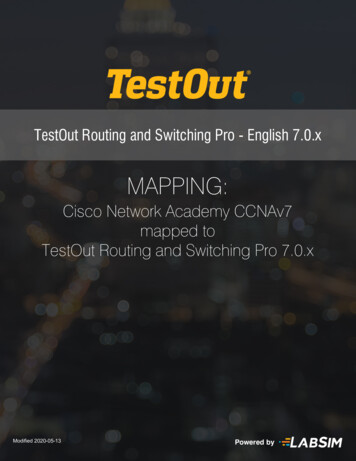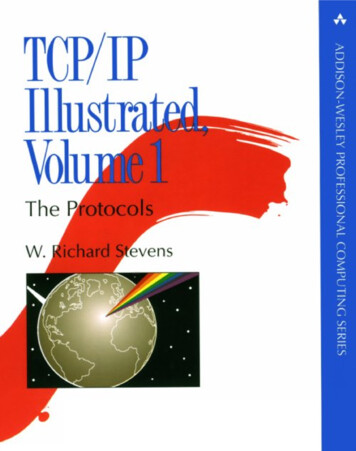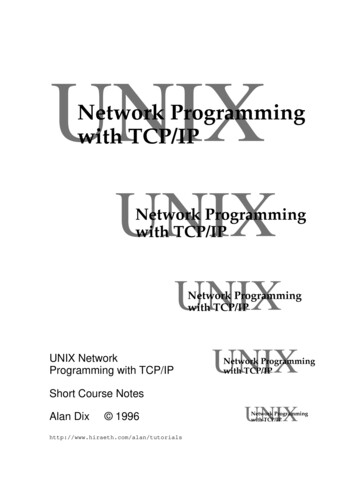
Transcription
UNIXNetwork Programmingwith TCP/IPUNIXNetwork Programmingwith TCP/IPUNIXNetwork Programmingwith TCP/IPUNIX NetworkProgramming with TCP/IPUNIXNetwork Programmingwith TCP/IPShort Course NotesAlan Dix rk Programmingwith TCP/IP
CourseOutlineUNIXNetwork Programmingwith TCP/IPAlan Dixhttp://www.hcibook.com/alanSession 1Internet BasicsSession 2First CodeSession 3Standard ApplicationsSession 4Building ClientsSession 5Servers ISession 6Servers IISession 7SecurityThree interrelated aspects: TCP/IP protocol suite standard Internet applications coding using UNIX sockets APITCP/IPUNIXShort Course NotesAlan Dix 19961
UNIXNetwork Programmingwith TCP/IPReadingBooks:1.W. Richard Stevens, "TCP/IP Illustrated. Vol. 1: The protocols", AddisonWesley, 1994, (ISBN 0-201-63346-9).Explains the protocols using network monitoring tools without programming.2.Douglas E. Comer and David L. Stevens, "Internetworking with TCP/IP.Vol.3: Client-server programming and applications BSD socket version",Prentice Hall, 1993, (ISBN 0-13-020272-X).Good book about principles of client/server design. Assumes you have someknowledge or at least some other reference for actual programming.3.Michael Santifaller , translated by Stephen S. Wilson, "TCP/IP and ONC/NFSinternetworking in a UNIX environment", 2nd Edition, Addison Wesley, 1994,(ISBN 0-201-42275-1).Covers more ground less deeply. Translation from German seems good.4.W. Richard Stevens, "UNIX Network Programming", Prentice Hall, 1990,(ISBN 0-13-949876-1).A programming book. I'm waiting for a copy, but Stevens is a good writer andthis book is recommended by other authors.See also: your local manual pages (man 2) RFCsRequests for comments (RFCs) these are the definition of the Internet protocols obtain via anonymous ftp from sun.doc.ic.ac.uk (193.63.255.1)login as anonymousgive your email address as passwordcd to rfcTCP/IPUNIXShort Course NotesAlan Dix 19962
UNIXNetwork Programmingwith TCP/IPUNIXNetwork Programmingwith TCP/IPUNIXNetwork Programmingwith TCP/IPSession 1Internet BasicsUNIXNetwork Programmingwith TCP/IPUNIXNetwork Programmingwith TCP/IP
UNIXNetwork Programmingwith TCP/IPSession 1Alan Dixhttp://www.hcibook.com/alan origins internets and the Internet protocol layers addressing common applications using them TCP and UDP port numbers APIs information callsTCP/IPUNIXShort Course NotesAlan Dix 19961
OriginsDevelopment of Internet & TCP/IP1968First proposal for ARPANET – military & gov’t researchContracted to Bolt, Beranek & Newman1971ARPANET enters regular use1973/4 redesign of lower level protocolsleads to TCP/IP1983Berkeley TCP/IP implementation for 4.2BSDpublic domain code1980srapid growth of NSFNET – broad academic use1990sWWW and public access to the InternetThe Internet Now TCP/IPUNIXgrowing commercialisation of the Internet50,000 networks6 million hosts30 million usersWWW dominating Internet growthShort Course NotesAlan Dix 19962
internets and the Internetan internet isa collection of interconnected networks (possibly different)e.g. X25, AppleTalkthe Internet isa particular internet which uses the TCP/IP protocols is global is hardware and network independent is non-proprietaryin addition supports commonly used applications publicly available standards (RFCs)the Internet is not (just) the web !TCP/IPUNIXShort Course NotesAlan Dix 19963
Characteristics of the InternetTo communicate you need: continuous connection common language means of addressingTCP/IPUNIXShort Course NotesAlan Dix 19964
Global Connectivityethernetrouterstoken ringsub-networkPPPstarnetworkrouterlots of networks: ethernet, FDDI, token ring AppleTalk (itself an internet!) etc. etc. etc.connected (possibly indirectly) to each other to the central ‘ARPAnet’ backbone in the USprotocols can be used in isolation? but is it the InternetTCP/IPUNIXShort Course NotesAlan Dix 19965
Protocols – the Language of theInternetTCP/IPOSIelectrical signalslow-level networks(e.g. ethernet)routersIP layer (end-to-end)ICMP (control and routing)TCP/UDP layerend-pointsapplication protocols(e.g. FTP, telnet, http)application user entation,Application(e.g. Fetch, mosaic)Standardisation: RFC (request for comments) and DoD MILRFCs also include (defined but not required): PPP, ethernet packaging, etc. FTP and other protocolsTCP/IPUNIXShort Course NotesAlan Dix 19966
AddressingJ. C. T. Jennings,Linbury Court School,Dunhambury,Sussex,England,Europe,Eastern Hemisphere,Earth,near Moon,Solar System,Space,near More Space†Without addresses can only broadcastFour types of address:① location independent② physical location③ logical location④ route basede.g. personal namese.g. letter addressese.g. organisational hierarchye.g. old email addressesTwo kinds of Internet address:IP address–type ② (sort of)e.g. 161.12.188.167domain name–type ③e.g. zeus.hud.ac.uk†extract from Jennings Goes to School, Anthony Buckeridge, Collins, 1950.TCP/IPUNIXShort Course NotesAlan Dix 19967
IP addresses 32 bit integer Often represented as 4 octets––2701966503161.12.188.167 General structure:net id { sub-net id } host id N.B. octets do not map simply onto componentsFive classes of IP address:Class AClass BClass C0netidsubnet/hostid7 bits24 bits1 0netidsubnet/hostid14 bits16 bits1 1 0netidhostid21 bits8 bitsClass D & Class E – experimental hostids may divided using subnet mask different for each major network (netid) TCP/IPUNIXneeds to be set for each machine on networkShort Course NotesAlan Dix 19968
Domain names human readable names. or at least ASCII ! Heirarchical (roughly organisational)zeus.hud.ac.uk–United Kingdomac–academichud –huddersfieldzeus–local machineN.B. USA is implicit – cs.washington.eduuk Decentralised administration Mappingfrom name to IP address– domain name serversalso reverse mapping C API :TCP/IPUNIXgethostbyname–name IP addressgethostbyaddr–IP address nameShort Course NotesAlan Dix 19969
Common applications FTP(file transfer protocol) SMTP(simple mail transfer protocol) telnet(remote logins) rlogin(simple remote login between UNIX machines) World Wide Web NFS TFTP(built on http)(network filing system – originally for SUNs)(trivial file transfer protocol – used for booting) SNMP(simple network management protocol) In each case protocols are defined User interfaces depend on platform(where relevant)TCP/IPUNIXShort Course NotesAlan Dix 199610
Hands on connect to zeus using telenet:%telnet zeus.hud.ac.uklogin: c5.etc. what happens if you just say “telnet what is zeus’ IP address? try “telnet connect to zeus using ftp:zeus”?aa.bb.cc.dd”(where ‘aa.bb.cc.dd’ is zeus’ IP address)%ftp zeus.hud.ac.ukconnect as yourself and then as anonymousRead between the linesTCP/IPUNIXShort Course NotesAlan Dix 199611
Network communicationsCommunication can be: Connectionless address every message like letters Connection based use address to establish a fixed link send each message using the link like telephoneN.B. both need an address some sort of system address bookor, publicly known addressesTCP/IPUNIXShort Course NotesAlan Dix 199612
Network communications – 2Other issues: ReliabilityDo all messages arrive?Do they arrive in the right order? Bufferingeffects responsivenesshides potential deadlock Messages or byte-streamsent:write 1 (len 26): “abcde.vwxyz”write 2 (len 10): “0123456789”received:read 1 (len 20): “abcde.qrst”read 2 (len 16): “uvwxyz012.89” TCP/IPUNIXfixed length messages or prefix with lengthShort Course NotesAlan Dix 199613
IP –the fundamental Internet protocolpoint to point between machines addressed using IP addressmessage (packet) basedunreliable network failures router buffers fill updynamic routing order may be lostheterogeneous intermediate networks TCP/IPUNIXfragmentationShort Course NotesAlan Dix 199614
TCP & UDPBoth built on top of IP addressed using port numbersprocess to process(on UNIX platforms)TCP connection based reliable byte streamused in:FTP, telnet, http, SMTPUDP connectionless unreliable datagram (packet based)used in:TCP/IPUNIXNFS, TFTPShort Course NotesAlan Dix 199615
Port numbers 16 bit integers unique within a machine to connect need IP address port noTCP connection defined byIP address & port of server IP address & port of clientUNIX port 1023 – root only used for authentication(e.g. rlogin)How do you find them? well known port numbersTCP/IPUNIXShort Course NotesAlan Dix 199616
Well known port numbersServicePort noProtocolecho7UDP/TCPsends back what it receivesdiscard9UDP/TCPthrows away inputdaytime13UDP/TCPreturns ASCII timechargen19UDP/TCPreturns charactersftp21TCPfile transfertelnet23TCPremote loginsmtp25TCPemaildaytime37UDP/TCPreturns binary timetftp69UDPtrivial file transferfinger79TCPinfo on usershttp80TCPWorld Wide Weblogin513TCPremote loginwho513UDPdifferent info on usersXserver6000TCPX windows (N.B. 1023)N.B. different ‘name’ spaces for TCP & UDPTCP/IPUNIXShort Course NotesAlan Dix 199617
API –the language of the programmerApplication Programmer InterfacesNot part of the Internet standard – but very important!A story about DOSTCP/IP stacks supplied by different vendors different device driversdifferent APIschaosAPIs depend on platform:UNIX–sockets (original Berkley system calls)–TLI (transport layer interface)Apple Mac– MacTCPMS Windows –WinSock (similar to sockets) UNIX TCP/IP API are kernel system calls Mac & Windows are extensions/drivers ( DLL)TCP/IPUNIXShort Course NotesAlan Dix 199618
Hands on copy skeleton.c from tcp directory edit to make two programs:getid.c– returns IP address of machinegetname.c –returns name of machine use the following C calls:gethostid()returns (lon unsigned) integer resultgethostname(buff,len)returns error codeputs name into buff (maximum len bytes) if you have time, play with telnet on different ports%TCP/IPUNIXtelnet zeus.hud.ac.uk port noShort Course NotesAlan Dix 199619
UNIXNetwork Programmingwith TCP/IPUNIXNetwork Programmingwith TCP/IPUNIXNetwork Programmingwith TCP/IPSession 2First CodeUNIXNetwork Programmingwith TCP/IPUNIXNetwork Programmingwith TCP/IP
UNIXNetwork Programmingwith TCP/IPSession 2Alan Dixhttp://www.hcibook.com/alan features of sockets API establishing TCP connections simple client/server program use it read & write with sockets wrapper functions what they do an echo serverTCP/IPUNIXShort Course NotesAlan Dix 19962/1
Sockets developed for Berkeley UNIX recall early Berkeley TCP/IP implementation first delivered with BSD 2.1 central features central abstraction - the socket - an end-pointlike an electrical connector not TCP/IP specific (e.g. UNIX named pipes) uses normal read/write system calls sockets associated with UNIX file descriptorsbut some not for normal I/O some extra system calls sits more comfortably with TCP than with UDPbecause of byte-stream nature of UNIX I/O special UDP functionse.g., recv(.) – accepts a UDP datagram additional non-socket functionse.g., gethostbyname(.) – domain name serverTCP/IPUNIXShort Course NotesAlan Dix 19962/2
Establishing a TCP ConnectionInitial .4.3 TCP is connection based. establishing it is a complex multistage process initially all machines are the same no special ‘server’ machines the difference is all in the softwareTCP/IPUNIXShort Course NotesAlan Dix 19962/3
Establishing a TCP ConnectionPassive Open21server151.100.17.25161.112.192.5 server process does a ‘passive’ open on a port it waits for a client to connect at this stage there is no Internet network traffic tells the TCP layer which process to connect toTCP/IPUNIXShort Course NotesAlan Dix 19962/4
Establishing a TCP ConnectionActive Open161.112.192.5 : 21212397serverclient161.112.192.5151.100.17.25 client process usually on a different machine performs an ‘active’ open on the port port number at the client end is neededusually automatic (e.g., 2397)but can be chosen network message server machinerequests connectionTCP/IPUNIXShort Course NotesAlan Dix 19962/5
Establishing a TCP .112.192.5 server side accepts and TCP connection established a bi-directional reliable byte-stream connection identified by both host/port numberse.g. 151.10017.25:2397/161.112.192.5:21 server port is not consumedcan stay ‘passive’ open for more connections like telephone call desk: one number many linesTCP/IPUNIXShort Course NotesAlan Dix 19962/6
Establishing a TCP Connectionand more .112.4.3 other clients can connect to the same port state for connections in the client/server only no information needed in the networknot like old style relay-based exchanges server can restrict access to specified host or port server can find out connected host/portTCP/IPUNIXShort Course NotesAlan Dix 19962/7
Passive & Active Openpassive – patient but lazyactive – industrious but impatientpassivewaits for request forconnectionwaits for everactivesends out request forconnectiontimes out normally server does passive open– waiting for client but not always (e.g. ftp) active opens can rendezvous . but may miss due to time-outs either can specify local portbut if not specified, allocated automaticallyTCP/IPUNIXShort Course NotesAlan Dix 19962/8
Simple client/server ‘talk’ uses simplified calls server handles only one client strict turntakinguser 1user 2zeus: simple-serverstart up completeio: simple-client -host zeusYou can send nowspeak: hi thereclient says: hi therespeak: nice day isn't itserver says: nice day isn't itspeak: bit cold hereclient says: bit cold herespeak: D (EOF) bye byezeus:server finished the conversationio:TCP/IPUNIXShort Course NotesAlan Dix 19962/9
Server Codeestablish portport sk tcp passive open(port)/* only done once */wait for client to connectclient sk tcp accept(port sk)/* repeated for multiple clients */then talk to clientfor(;;) {/* wait for client’s message */len read(client sk,buff,buf len);buff[len] '\0';printf("client says: %s\n",buff);/* now it’s our turn */printf("speak: ");gets(buff);write(client sk,buff,strlen(buff));}N.B. strict turn taking: client–server–client–server .TCP/IPUNIXShort Course NotesAlan Dix 19962/10
Client Coderequest connection to serverserv sk tcp active open(host,port)/* waits for server to accept*//* returns negative on failure*//* host is server’s machine*/then talk to serverfor(;;) {/* our turn first */printf("speak: ");gets(buff);write(serv sk,buff,strlen(buff));/* wait for server’s message */len read(serv sk,buff,buf len);buff[len] '\0';printf("server says: %s\n",buff);}N.B.TCP/IPUNIX➀ opposite turn order➁ no error checking!Short Course NotesAlan Dix 19962/11
Hands on copy simple-client.c from tcp/session2 directory simple-client.c simple-server.c makefile compile and run the programs: make simple– compiles them both on one machine type:simple-server on another type:wheresimple-client machine-namemachine-name is the name of thefirst what happens if you re-run the server straight afterit finishes? use the -port optionzeus: simple-server -port 3865io:simple-client -host zeus -port 3865 try a port less than 1024!TCP/IPUNIXShort Course NotesAlan Dix 19962/12
read & writeReminder:ret read(fd,buff,len)intfdchar *buffintlenintret a file descriptor (int), open for readingbuffer in which to put charsmaximum number of bytes to readreturns actual number readis 0 at end of file, negative for errorbuff is not NULL terminatedleave room if you need to add ‘\0’!retret write(fd,buff,len)intfdchar *buffintlenintret ––––––––a file descriptor (int), open for writingbuffer from which to get charsnumber of bytes to writereturns actual number writtenis negative for error, 0 means “end of file”may be less than len e.g. if OS buffers full* should really check and repeat until all gone * buff need not be NULL terminatedif buff is a C string, use strlen to get its lengthretretN.B. Both may return negative after interrupt (signal)TCP/IPUNIXShort Course NotesAlan Dix 19962/13
read & write with sockets similar to normal UNIX pipes bi-directional byte stream read and write to same file descriptordifficult to close one directionspecial socket call shutdown(sock,dir) reading may block reading from a file either:(i) succeeds(ii) gets end of file (ret 0)reading from a socket waits until(i) network data received (ret 0)(ii) connection closed (ret 0)(iii) network error (ret 0) writing may block writing to a socket may(i) send to the network (ret 0)(ii) find connection is closed (ret(iii) network error (ret 0)it may return instantlybut may block if buffers are fullBEWARE –TCP/IPUNIX 0)may work during testingthen fail in useShort Course NotesAlan Dix 19962/14
Wrapper Functions (1) not real socket functions simplified versions for examplesret parse network args( &argc, argv,&host, &port, &errmess )scan command arguments for network optionsport sk tcp passive open(port)server performs passive openserv sk tcp active open(host,port)client performs active openclient sk tcp accept(port sk)server accepts client connectiondoes not use socket calls parse network args the rest package one or more socket callsTCP/IPUNIXShort Course NotesAlan Dix 19962/15
Wrapper Functions (2)ret parse network args( &argc, argv,&host, &port, &errmess ) scans and edits argument listlooks for options:-host name-port nosremoves them from argument listsets the arguments host and port if options foundset either host or port to NULL to disable optionsreturns 0 for successnon-zero failed – errmess set to appropriate messageport sk tcp passive open(port)int portint port sk––port number to usefile descriptor of socket① creates Internet TCP socketport sk socket( AF INET, SOCK STREAM, 0 );② ‘binds’ socket with right port and address 0.0.0.0(special address means “this machine”)bind( port sk, &bind addr, addr len );N.B. port skTCP/IPUNIXis not used for normal reading and writingShort Course NotesAlan Dix 19962/16
Wrapper Functions (3)serv sk tcp active open(hostname,port)char *hostnameintportintserv sk–––name of server’s machineport number to usefile descriptor of socket① finds IP address of hosthostIP gethostbyname(hostname);② creates Internet TCP socketserv sk socket( AF INET, SOCK STREAM, 0 );③ ‘connects’ socket to appropriate port and hostconnect( serv sk, &bind addr, addr len ); rendezvous with the server happens at ③socket serv sk can then be used to talk to the serverclient sk inttcp accept(port sk)port sk–file descriptor of socket① performs raw accept callclient sk accept(port sk, &bind addr, &len); waits for rendezvous at ①when it returns client sk can be used to talk to clientTCP/IPUNIXShort Course NotesAlan Dix 19962/17
Special IP addresses bindcall in tcp passive open uses IP address 0.0.0.0One of several special IP addresses0.0.0.0 source onlydefault IP address – ‘local machine’filled in by socket API call127.0.0.0 loopback address,also means ‘the local machine’usually used as recipient for local serverdoesn’t normally hit networkN.B. can also connect to own IP address255.255.255.255 limited broadcast (doesn’t pass routers)any netid – subnetid/hostid –1any netid & any subnetid –hostid TCP/IPUNIX–1broadcast to specified net or subnetN.B. need to know subnet maskShort Course NotesAlan Dix 19962/18
Hands on build an echo server copy simple-server.c and call it echo-server.c alter code so that instead of asking the user forinput (gets) it simply uses the last message from theclient (in buff) you will need to add to the makefile:echo-server: echo-server.o (MYLIBS)cc (CFLAGS) -o echo-server echo-server.o (MYLIBS)N.B. this must be a tab compile and run your code does your server echo everything once or twice toits terminal? the server exits after it has finished echoingmake it continue to wait for additional clients(don’t try for two at once!)TCP/IPUNIXShort Course NotesAlan Dix 19962/19
UNIXNetwork Programmingwith TCP/IPUNIXNetwork Programmingwith TCP/IPUNIXNetwork Programmingwith TCP/IPSession 3UNIXApplicationProtocolsUNIXNetwork Programmingwith TCP/IPNetwork Programmingwith TCP/IP
UNIXNetwork Programmingwith TCP/IPSession 3Alan Dixhttp://www.hcibook.com/alanStandard Applications trusted login – rlogin negotiating options – telnet world wide web– http peeking file transfer – ftp standard response codes electronic mail – SMTP drive it by hand argc , argv & makefiles build your own mail clientTCP/IPUNIXShort Course NotesAlan Dix 19963/1
Types of Protocoluser character stream used by remote terminal/login applications( rlogin & telnet )most of the traffic is uninterpretted datasome embedded control sequencesascii turn-taking protocols includes ftp, SMTP, httphuman readable client & server messagesusually line orientedturn-taking typically: client commandserver response··· but roles may reversebulk data may be embedded (SMTP, http)or use separate connection (ftp)binary protocols used for low level protocols:TCP/IP itself!SNMP – simple network management protocolNFS (built on top of RPC – remote procedure call) TCP/IPUNIXissues such as byte order importantShort Course NotesAlan Dix 19963/2
Remote Terminal Access:rlogin and telnet one of the earliest Internet application areas the client end– interacts with the user the server end – shell or command r➃basic pattern:① user types characters② the client sends them to the server③ the server passes them on to the shell④ shell generates output⑤ server passes output to client⑥ client puts output on user’s screenTCP/IPUNIXShort Course NotesAlan Dix 19963/3
Remote Terminals – Issues initialisation and authentication① how does the server know who you are?② how do you know the server is official?answer to ②: the server is on a reserved port ( 1024)N.B. only works for UNIX servers! how to deal with special characters. including end-of-line ! which end performs different things: user flow control (crtl-S, ctrl-Q) line editing echoing how do the client and server communicate: user interrupts window size changes who does what if embedded control characters are usedwhat happens if the user types them?TCP/IPUNIXShort Course NotesAlan Dix 19963/4
rlogin simple stable protocol designed for UNIX–UNIX logins can make more assumptions( terminal handling, interrupts, etc. ) authentication by ‘trusted’ hosts no password required if:client uses port 1024andclient host is in ‘.rhosts’ file means that client must be setuid to root responsibility echoing – server flow-control – client on server request client–server communication client server initialisation string client server window size change:ctrl chars – 2 bytes of 255followed by window size in 2 bytesno protection against user typing it! TCP/IPUNIXserver client requests:special characters (bytes x02,x10,x20,x80)marked by URG (urgent) pointerShort Course NotesAlan Dix 19963/5
Urgent Data sometimes called out-of-band data. . . but it’s not! data sent in normal TCP stream special URG pointer set officially to the last byte of urgent data BSD set it one beyond!ometext 0x80 morURG pointerBerkeley URG pointer! client should:① read until urgent data reached② if necessary discard intervening data(e.g. if insufficient buffer space to store it)problem with ① URG pointer says where it ends . . . . . but how do you know where it starts? have to have special codes again with UNIX sockets send urgent data with ‘send’ system call recipient gets a SIGURG signalTCP/IPUNIXShort Course NotesAlan Dix 19963/6
telnet cross platform more complex many downward-compatible options can be used to connect to non-login services client authentication not in protocol – application specifice.g. getty responsibility client may handle echoing, line editing etc.subject to option negotiation NVT character set needed because cross-platform 7 bit US ASCII end-of-line sent as “\r\n” (carriage return, line feed) carriage return sent as “\r\0” also used by SMTP, ftp, finger etc. high bit free for control characters!TCP/IPUNIXShort Course NotesAlan Dix 19963/7
telnet – 2control codes introduced by byte 255 called: IAC – interpret as commandfollowing byte is actual control codeexamples:255236241243––––the actual byte 255 (needed for binary mode)end of fileno opbreakoption negotiation control DODONTsub-option beginsub-option endoption negotiation many different options: echoing line editing, flow control window size informationclient and server play “will you/wont you”to determine common protocoljust like fax machines and modemsTCP/IPUNIXShort Course NotesAlan Dix 19963/8
http the World Wide Web protocol protocol: ASCII control messagesstandard data formats for pages/images uses single step transactions①②③④establish TCP connectionclient sends requestserver sends reply pageconnection closed why transaction based? client end–many different servers(hypertext links to different sites) server end – many clientsload time interaction time (ideally!) why use TCP? TCP/IPUNIXhigh cost of establishing connectionwide area, large messages & simple clients reliable communication neededShort Course NotesAlan Dix 19963/9
Hands on peeking use the program proxy in tcp/session3 it sits between client and server use it to see how http works:① run: proxy www.hud.ac.uk 80 -port 8800② start up Netscape using background menu③ go to the url:http://www.hud.ac.uk/schools/comp maths/private/alan/alandix.html④⑤ now edit the host name in the url fieldif your machine is iochange //www.hud.ac.uk to //io.hud.ac.uk:8800the 8800 is to set the port number used by proxyhit return and watch the proxy windowyou can do the same with telnet:① run:proxy zeus.hud.ac.uk① then:telnet io 230023 -port 2300N.B. cannot be used for protected ports (ftp, mail etc.) try using the -v option of ftptype:ftp -v prometheus.hud.ac.ukTCP/IPUNIXShort Course NotesAlan Dix 1996 3/10
File Transfer ProtocolFTP used to transfer files and list directory contents uses two types of connection:control – for commands and responsesdata– for files and listings protocol for control is ascii turn-takingclient command, server response, . client commands nearly user level, including:USERTCP/IPUNIXPASSuser name for connectionoften ‘anonymous’ is acceptedpassword, email address for anonymousGETreceive a file from remote machinePUTsend file to remote machineCWDchange remote directoryLISTchange remote directoryPORTtell server what data port to useHELPinfo about commands supportedQUITfinish sessionShort Course NotesAlan Dix 1996 3/11
FTP - 2control and datacontrol connection server waits (passive open) on port 21client establishes connection (active open)client sends ascii commands – one per lineserver responds: single or multi-line responsewhen required a data connection is establisheddata connection client performs a passive open on some port(may leave OS to determine port number) client tells server using control connectionPORT 161.112.192.5.9.93port 2397 ( 9*256 93) on host 161.112.192.5when data transfer is required client sends appropriate commande.g. GET simple-client.cthen waits listening for connection server performs an active open on portthen sends data server tells client when transfer is completee.g. 226 Transfer complete.then both sides (usually) close the data portTCP/IPUNIXShort Course NotesAlan Dix 1996 3/12
standard response codes ftp server replies with lines such as:200 PORT command successful SMTP and some other protocols use similar codes three digit codes – type given by first digit:1yz – expect further reply from server2yz – all OK3yz – more required from client4yz – temporary failure (try again)5yz – error or permanent failure single-line response general format999 a text messagespace here multi-line responseeither:hyphen means ‘more to come’999-first line999-one or more further lines999 the last linespace here on last lineorTCP/IPUNIX999-first linelots of lines all starting withat least one space999 the last lineShort Course NotesAlan Dix 1996 3/13
Simple Mail Transfer ProtocolSMTP allows: mail client (user interface) to send via server servers to talk to one another(one server takes ‘client’ role)note: not used by user interface for receipt sendmail is common SMTP server under UNIXclient commands:TCP/IPUNIXHELOclient tells server who it isMAILinitiates message and sets senderRCPTsets one of the recipientsDATAsays actual message content followsVRFYcheck that recipient exists (no mail sent)EXPNexpand mail alias (no mail sent)RSETstart from scratchEHLOsee if server handles advanced featuresQUITfinish sessionShort Course NotesAlan Dix 1996 3/14
SMTP – 2 authentication, servers typically: do not trust HELOuse reverse name mapping instead do trust sender name (From:)how could they verify it? SMTP specifies delivery not content other standards used for content: non-ASCII characters in headers ?ISO-8859-1?Q?Alan 20Dix? MIME for multi-part mixed content messagessimple mail message is just: headerFrom: alan@zeus.hud.ukTo: R.Beale@cs.bham.uk.acSubject: HCI book 2E blank linebodyRussell,have you heard from Prentice Hallyet concerning the web pages?AlanTCP/IPUNIXShort Course NotesAlan Dix 1996 3/15
Hands on see what it does we want to send a mail message using raw SMTP! first of all see how ‘mail’ does itcannot use proxy as SMTP is at port 25 (protected) in
with TCP/IP Reading Books: 1. W. Richard Stevens, "TCP/IP Illustrated. Vol. 1: The protocols", Addison Wesley, 1994, (ISBN 0-201-63346-9). Explains the protocols using network monitoring tool


